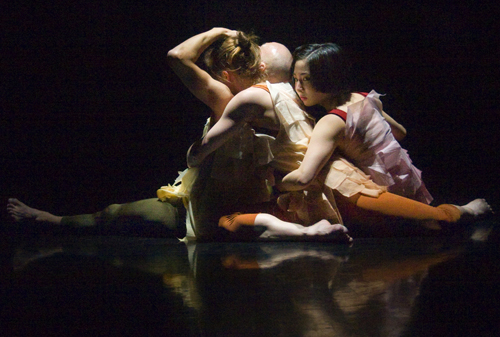coalesce and armour - An Audio Action Tour

The evening begins with an “audio house tour” - which turns out to be an engaging lecture by choreographer / dancer Peggy Baker explaining how the art of Canadian artist Sylvia Safdie inspired and influenced the creation for her trio coalesce. Safdie provided not only paintings but also a series of short films where she utilized a combination of slow motion, reverse and looping techniques to depict the motion of a beetle. "This beetle was lying on its back, and it was basically in its death throes," Baker is quoted in a recent interview with the North Shore News. "It was going through incredible movement patterns with its many limbs and antennae, walking and curling and opening up. [Safdie] was basically choreographing this beautiful beetle."
The talk, while brief, opens the creative process to the audience member, which when combined with the dancers demonstrating some of the key phrases articulating the action of the movement, provides a context to the piece which might otherwise be inaccessible. It also reminded me how complex the process of creation is. Numerous and varied artistic voices, outside of that of the choreographer, must come together to create a work, and they all supply their own unique perspective. I find it amazing at times that the process ever actually fuses, as it does in this instance, superbly.
armour, choreographed by Doug Varone, is an elegant and moving duet performed by Baker and veteran dancer Larry Hahn. Varone used a series of essays from the Lewis Thomas classic The Lives of a Cell as his inspiration for his piece. The result is deeply intimate exploration of communication through touch.
It is followed by coalesce, the trio choreographed by Peggy Baker. Andrea Nann, Sean Ling, and Sahara Morimoto transform themselves beautifully into three unique glassy eyed six-limbed creatures that share a seemingly loving parasitic dependency. Through a series of complex yet understated movements they explore the relationship between vibration and touch as the foundation for communication in the natural world.
The lighting, by Mark Parent, is stark, exact and seamless. The music composed by Debashis Sinha, is clean and subdued, reminiscent of cicadas on an urban streetscape.
This Peggy Baker Dance Projects production, presented at the Firehall Arts Centre until January 11 is not to be missed.
A dead beetle lies on the path through the field.
Three pairs of legs folded neatly on its belly.
Instead of death's confusion, tidiness and order.
The horror of this sight is moderate,
its scope is strictly local, from the wheat grass to the mint.
The grief is quarantined.
The sky is blue.
To preserve our peace of mind, animals die
more shallowly: they aren't deceased, they're dead.
They leave behind, we'd like to think, less feeling and less world,
departing, we suppose, from a stage less tragic.
Their meek souls never haunt us in the dark,
they know their place,
they show respect.
And so the dead beetle on the path
lies unmourned and shining in the sun.
One glance at it will do for meditation —
clearly nothing much has happened to it.
Important matters are reserved for us,
for our life and our death, a death
that always claims the right of way.
by Wisława Szymborska
‘Seen from Above’ from Poems New and Collected: 1957-1997



